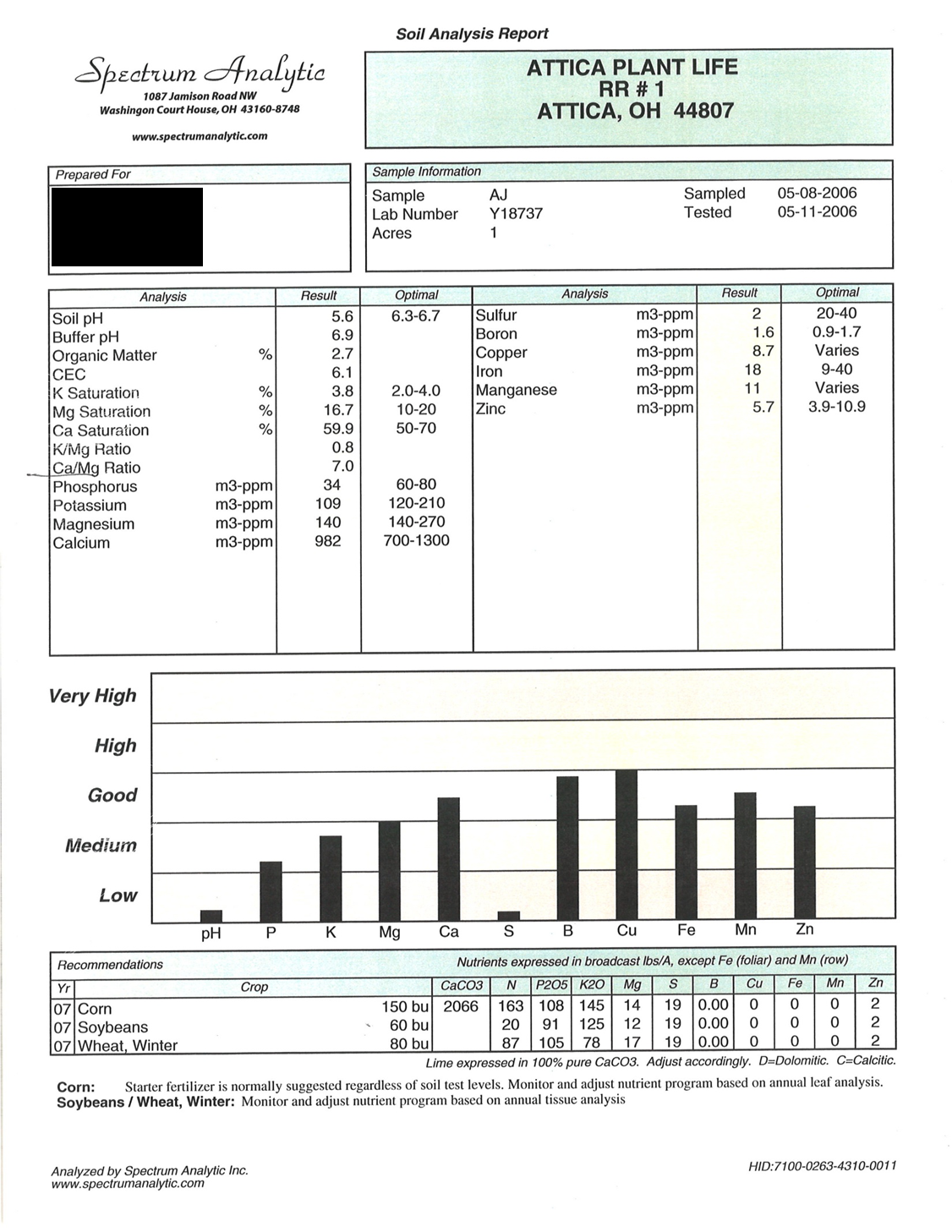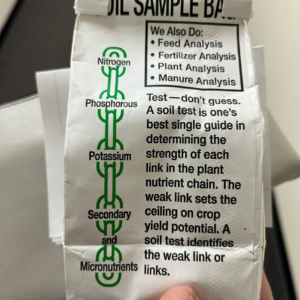By Sam Foley
Background
One of the most common questions we get is “How can I increase the soil health in my home garden?” A soil test is the simple answer. Our office offers soil testing through Spectrum Analytic Inc, a laboratory out of Washington Court House, Ohio. According to Spectrum Analytic “A soil test is one’s best single guide in determining the strength of each link in the plant nutrient chain. The weak link sets the ceiling on crop yield potential. A soil test identifies the weak link or links.” These weak links are specific nutrient values where your soil may be lacking. Additionally, soil testing is a great tool for someone interested in conservation because after we know the nutrient content of the soil, we can amend only what is needed. This helps avoid applying excessive nutrients, which can be lost to runoff, and saves the grower money. A soil test is only as beneficial as our understanding of the report so I am going to use this space to describe each parameter included in the basic test and how to take the best sample you possibly can.
How to Take a Soil Sample
Soil test results are only going to be as accurate as the sample that was collected. We have a great description of how to collect the best representative sample. Please follow this link for additional information: https://richlandswcd.net/residential/soil/#soil-testing
Interpreting Results
You’ve submitted your sample and have received a report, so what does it all mean? Well, that’s part of what I’m here for, to help interpret these charts and graphs. I’m always happy to discuss these reports and try to always give my quick recap when forwarding results to owners. This section will provide a brief explanation of each parameter from the Basic Soil Test.
- pH is a measurement indicating the active acidity or alkalinity. pH is measured on a scale of 0-14. 7 is neutral, values below seven are acidic, and values above 7 are alkaline. Certain nutrients are only available to a plant within a very specific pH range, and this is why pH is absolutely crucial.
- Buffer pH is what is used to determine the lime requirement. The lower the buffer pH result, the more soil will resist a change in pH. In this case, more lime would be required to raise the pH to the desirable level.
- Organic Matter, oftentimes referred to as humus, consists of plant and animal detritus (decaying matter) that soil microbes can synthesize. Organic matter is packed full of carbon, oxygen, and hydrogen as well as macro and micro nutrients.
- C.E.C. stands for Cation Exchange Capacity which is a measurement of the soil’s capacity to hold exchangeable nutrients with a positive electrical charge (cations). Soils with a high C.E.C. can supply a large amount of nutrients, but they also require a large amount of fertilizer to be considered fertile. Higher C.E.C. values can indicate presence of clay and organic matter, where a low C.E.C. may indicate sandy soil, which is typically low in organic matter.
- Potassium (K) is an important macronutrient. It’s required for metabolic and physiological function. It also plays a role in photosynthesis and plant food formation.
- Magnesium (Mg) is another macronutrient. Again, it plays a big role in photosynthesis and is an enzyme activator.
- Calcium (Ca) is essential for many plants functions, including proper cell division and cell wall development. Also nitrate uptake and metabolism. Enzyme activity and starch metabolism also are dependent on calcium presence.
- Phosphorus (P) plays a major role in photosynthesis, respiration, seed and fruit production, as well as energy storage, transfer and production.

Recommendations
This section is provided based on the target crop, and if provided, yield goals. Nutrient recommendations are given in pounds per acre and can easily be converted to match one’s target area. Not only are nutrient recommendations provided but also recommendations for adjusting pH to the desired level. Lime is prescribed in situations where pH is too acidic, and sulfur is used to lower pH when soil is too alkaline. Following the provided recommendations should result in more ideal production in one’s garden.
Conclusion
If you’ve ever considered testing the soil in your home garden hopefully this article has provided a good overview of what to expect from the test report and how to begin to interpret those results. Soil testing is a great tool in the conservationist’s belt. Only applying what is needed saves time, money and resources. By following the recommendations provided we can begin to build up our soil into the healthiest state it’s been in a long time. Stay tuned for future articles as I plan to explore more ways to build up our soil by increasing levels of organic matter via composting.

Learn More
- How to Read the Spectrum Analytic Soil Test Report
- Interpreting Lawn and Garden Soil Test Results
- How to Take a Soil Sample
